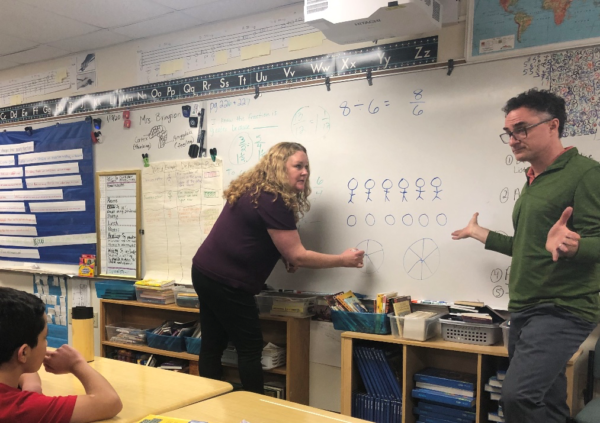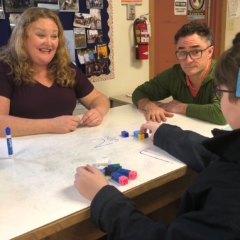By guest bloggers NBCT Heather Byington and NBCT David Buitenveld
What happens when a middle school math teacher and an elementary teacher co-teach math to 5th graders for a quarter? David Buitenveld, a middle grade math teacher leader who recently received his National Board Certification, and Heather Byington, a veteran elementary teacher leader and long-time NBCT, discuss their journey of collaboration, with the Architecture of Accomplished Teaching as the common path.

David (newly-certified NBCT and 5-year middle level math teacher):
During my NBCT journey last year, I spent more time than previously with the question “what do you know about your students?” and the answer, embarrassingly often, was “not that much.” Keeping that question present (a key takeaway from the National Board process) led me to realize that although I understood the mathematical ideas students encounter in elementary grades, I didn’t have knowledge of their lived experience of 5th grade, and how that experience affected their transition to middle school math. Co-teaching with Heather was a chance to experience 5th grade math and see their world in action.
Heather (long-time NBCT and 20-year teacher):
When David asked to co-teach math in my classroom, I wondered if it would be intimidating to work with a math expert. I quickly realized that he is more skilled at constructing inquiry-based discussion around a math concept, while I feel more comfortable with direct instruction. My first attempt flopped, while he watched! But David jumped in and helped me make more sense of the math for students! I learned from him that it’s okay to try new things and have them flop. When kids see that I try, fail, and keep trying, they’re willing to keep trying too.
David:
I had visited 5th grade classes (including Heather’s) in previous years to give a brief Q and A about 6th grade, but I was nervous about participating (vs. just observing) with a much more experienced teacher. Heather’s not alone – I’ve had my own flops — students are struggling and it isn’t clear what question I should ask or move I should make to help them. The first discussion I led with Heather’s students felt like this for me too. Students were at a place of mixed confusion and understanding and I said, “We are going to wrap this up now, and I am going to invite you all to let this be a wondering.” And then I clearly stated the unresolved idea. To me, this is a completely normal part of doing math – it is sometimes a struggle that doesn’t have immediate resolution — and it’s ok.
Heather:
There are crucial moments with co-teaching that occur in a lesson, when two accomplished teachers working together generate amazing energy. For example, David leads a discussion. The students are not responding to his questions. My experience with helping struggling students activates. I sketch a model. David assigns numbers to the model, and the students now contribute their ideas. Electricity snakes through the helix of the Architecture. I’m learning. The kids are learning. This is the feeling I hoped I’d have as a teacher and the feeling I have co-teaching with David.
David:
When I lead a lesson, I am attending to so many things: is the conversation productive, or might it need to be nudged with a particular question? Who is participating and do I need to help engage more of the class? Is that student frowning because they are productively struggling or because they are lost and frustrated? What I value most about co-teaching is that it affords the opportunity (when not leading the lesson) to take a learner’s perspective; the parts of my attention that notice and wonder can be more fully engaged. Those crucial moments often occur when a teacher can verbalize a wondering with the class. When Heather is leading, I enjoy raising my hand and asking the class a question, as if I were one of the students: “I noticed so-and-so said…” and ”Now I wonder if that always works?” “What if…” and “Can anyone think of a way to…” “Did that remind anyone of…”
Heather:
The first discussion David led with the students was on seeing fractions as division. Fast forward and now we’re studying division, learning how to write the remainder in fraction form. One student said, “Oh, you just want us to answer the division problem in the form of a mixed number?” “Yes!” This depth of understanding in my students is a direct result of our collaboration.
David:
A couple of years ago I was intrigued by a TED talk given by Professor Roger Antonsen talking about different perspectives in mathematics. Different perspectives give us different noticings and wonderings, leading to different insights and understandings. Working with remainders is tricky and the perspective of division stories as fractions seems to have helped Heather’s students make sense of them.This speaks to the power of co-teaching – that we can offer different perspectives as teachers which in turn helps students navigate complex topics and make connections they might not otherwise have made.
Heather:
Where am I now? My ability to lead inquiry-based math discussions continues to be an area of focus for me. I reached out to an instructional coach, and I’m investigating resources she provided that can support my learning and continued success with students. I continue to note the instructional decisions David makes while leading these discussions and the math ideas that my students reveal through them.
David:
Where am I now? My area of focus is in supporting students that are struggling with concepts, and it is invaluable to watch a veteran like Heather do this. Co-teaching gives me opportunities both to see what Heather does, and to try things with a more experienced teacher giving feedback. One conversation among my team’s grade level teachers has gone something like this: “It would really help students if they could do X, Y, and/or Z by the time they left your class and started mine [next grade].” We spend a lot of time thinking about what skills students need for the following year. Several weeks of co-teaching and working with 5th graders has let me share and explore some of these ideas with Heather, but it has also flipped this conversation for me, and I am thinking about what my 6th grade class could be like to ease the transition into middle school math.
The Architecture of Accomplished Teaching provided common ground on which to begin our collaboration. Despite our differences – goals for engaging in co-teaching, school settings, and teaching experience, the Architecture has helped us communicate effectively about instruction. The energy from the collaboration ripples outward to include our colleagues as we share insights with others. The cycle continues, as David plans to continue co-teaching with Heather and the other teachers in the 5th grade team for the rest of the year.
Bios:

David Buitenveld is a newly National Board Certified Teacher in the area of Early Adolescent Mathematics, who teaches 6th and 7th grade at Nisqually Middle School in North Thurston Public Schools, in Lacey, Washington, and is in his 5th year of teaching.

Heather Byington is a National Board Certified Teacher in the area of English as a New Language who teaches 5th grade at Lydia Hawk Elementary in North Thurston Public Schools, in Lacey, Washington, and has been teaching for 20 years. She is a Facilitator for National Board Teacher Certification candidates.

This was great! I am currently co-teaching with our SpEd teacher in one of my seventh-grade classes and it is wonderful. We have each other’s backs, so to speak, and the kids get the benefit of our different styles and backgrounds. It sounds like your students truly had the best of both worlds.
As a student on the way to becoming a teacher this gave me food for thought for when I begin teaching. Thank you!
Teresa Howells
I really like how you connected with the NBCT question of “Who are your students?” I think a lot about this in teaching math. I know my students are from homes struggling with poverty and often are have trauma histories. These two factors set them up for troubles with working memory, which you can imagine greatly impacts math skills. We have been exploring building our students’ capacities in working memory and will be dedicating a lot of our PD to this next year. This action came directly from the NBCT process and hopefully will show impact on our test scores and more importantly, our students’ learning.
Thanks for your post!
Gretchen
Thank you for writing Gretchen! I am aware of challenges with working memory (e.g. the work of David Sousa), but I haven’t thought about specific strategies for building working memory capacity. This is totally fascinating and I am curious how this will work! Thank you for sharing another cool way (and a new one for me) the NBCT process helps us uncover who our students are and how we can help them.
I appreciate you two starting this conversation! As a school counselor, I love to work in the classroom to find the social/emotional components of the lesson in (insert subject area). You both do a great job of explaining what happens in the content and facilitation when interdisciplinary collaboration occurs in front of your students. The other benefit is that THEY witness your collaboration. They will borrow your humility to publicly grow from your interactions with each other when they are in situations they too can collaborate.
Thank you for sharing this,
Susie
Susie,
Thank you for sharing your perspective as a Counselor! I had seen the benefit of David establishing relationships with my students before they headed to middle school to possibly join his classes, but I hadn’t considered how my students seeing how David and I interact through the course of the lesson also can strengthen their social skills. Thank you for your insights!
I really appreciate that the two of you have this shared framework to begin collaborating (the architecture of accomplished teaching). How powerful is it that you both approach a lesson from the same place… the students. You have an automatic structure for the work you do. When working in PLCs with other NBCTs, I have noticed a difference. Your writing makes me realize that it was exactly this!
Wade,
I completely agree! It’s so satisfying as a teacher when I’m communicating with another educator about student learning, and we’re both accustomed to functioning as educators within the framework of the Architecture. It feels like we can skip a bunch of steps in terms of communicating our philosophies of teaching and learning and also automatically have a common language we can use to talk about our work. It’s great to hear you’ve had a similar experience!
Co-teaching is a great opportunity to learn and collaborate in a professional way with our colleagues. The co-planning process encourages two teachers to bounce ideas off each other in order to deliver the strongest, most effective and creative lessons.
Great job Heather!
Thank you, Marianella! I have certainly found what you said to be true when co-teaching with you and others!
Marianella,
Thank you for leaving this article about collaboration among educators in my mailbox at school. I found the online version and thought I’d post the link here for others who are interested in collaboration and may want to check it out.
https://www.edsurge.com/news/2020-01-15-why-these-educators-meet-regularly-to-align-instruction-with-mind-brain-and-education-research